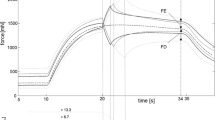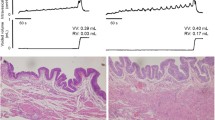Abstract
Purpose
Knowledge of the fundamental properties of the urinary bladder is required to better understand its pathological conditions. Research on the passive and active properties of the bladder during stretching and contraction is important. The bladder is not passive during the filling phase. Spontaneous contractions are observed as variations in pressure, which are mostly related to urgency and/or incontinence and sometimes to pelvic pain. The purpose of this study was to describe distributed spontaneous contractions and micromotions (MMs), which besides being related to symptoms, are crucial in the physiological process of accommodation, and to express accommodation in a concept.
Method
After describing MMs in the bladder wall as the type of spontaneous activity that may not be reflected in detrusor pressure and as a source of afferent nerve activity, its biomechanical effects are considered. In a simple mechanical model, contractions and elongations are related to the plastic elongated state of the bladder. The changing distributed character of contractions and elongations in the bladder wall is represented in a modular scheme.
Results
Distributed transient contractions and MMs yield a balanced dynamic plastic state of the regions of the bladder wall. An almost constant detrusor pressure can be attributed to the active accommodation of detrusor pressure to changes in bladder volume.
Conclusion
Localized contractile activity and MMs that change the plastic elongated state of varying bladder regions are biomechanically effective in the active accommodation of detrusor pressure to changes in bladder volume. According to this concept, autonomous bladder wall activity as a source of nerve activity, also is crucial for active accommodation.



Similar content being viewed by others
References
Coolsaet BLRA, Blok C, van Venrooij GEPM, Tan B (1985) Subthreshold detrusor instability. Neurourol Urodyn 4:309–311
Cullingsworth ZE, Kelly BB, Deebel NA, Colhoun AF, Nagle AS, Klausner AP, Speich JE (2018) Automated quantification of low amplitude rhythmic contractions (LARC) during real-world urodynamics identifies a potential detrusor overactivity subgroup. PLoS ONE 13:e0201594
Heppner TJ, Tykocki NR (2016) Transient contractions of urinary bladder smooth muscle are drivers of afferent nerve activity during filling. J Gen Physiol
van Duyl WA (1985) Spontaneous contractions in urinary bladder smooth muscle: preliminary results. Neurourol Urodyn 4:301–307
van Duyl WA, van der Hoeven AAM, de Bakker JV (1990) Synchronization of spontaneous contraction activity in smooth muscle of urinary bladder. Neurourol Urodyn 9:547–550
Coolsaet BLRA, Blaivas JG (1985) No detrusor is stable. Neurourol Urodyn 4:259–261
Kinder MV, van Waalwijk van Doorn ESC, Gommer ED, Janknegt RA (1998) A non-invasive method for bladder electromyography in humans. Arch Physiol Biochem 106:2–11
Coolsaet BLRA, van Duyl WA, Van Os-Bossagh P, De Bakker HV (1993) New concepts in relation to urge and detrusor activity. Neurourol Urodyn 12:463–471
van Os-Bossagh P, Kosterman LM, Hop WCJ, Westerhof BE, de Bakker JV, Drogendijk AC, van Duyl WA (2001) Micromotions of bladder wall in chronic pelvic pain: a pilot study. Int Urogynecol J 12:89–96
Duyl WA van (1995) Method and apparatus for examining the functioning of body structures comprising smooth muscle walls. Int Patent PCT/IB95/00838
-Kosterman LM, Os-Bossagh P van, Drogendijk AC, Bakker JV de, Duyl WA van (1996) A new technique for detection of micromotions at 16 locations in bladder wall, Proc 26th ICS Athens 57–61
Drake MJ, Harvey IJ, Gillespie JI (2003) Autonomous activity in the isolated guinea pig bladder. Exp Physiol 88:19–30
Drake MJ, Gillespie JI, van Duyl WA (2004) Localized modular contractions in the normal human bladder and in urinary urgency. J Urol 171:138–139
Lentle RG, Reynolds GW, Janssen PWM, Hulls CM, King QM, Chambers JP (2015) Characterisation of the contractile dynamics of the resting ex vivo urinary bladder of the pig. BJU Int 116:973–983
Hammad FT, Stephen B, Lubbad L, Morrison JFB, Lammers WJ (2014) Macroscopic electrical propagation in the guinea pig urinary bladder. Am J Physiol Ren Physiol 307:F172–F182
Vahabi B, Drake MJ (2014) Review physiological and pathophysiological implications of micromotion activity in urinary bladder function. Acta Physiol 1–11
Drake MJ, Fry CH, Hashitani H, Kischner-Hermanns R, Rahnama IMS, Speich JE, Tomoe H, Kanai AJ, McCloskey KD (2018) What are the origins and relevance of spontaneous bladder contractions?, ICI-RS 2017. Neurourol Urodyn 37:S13–S19
van Mastrigt R, Coolsaet BLRA, van Duyl WA (1978) Passive properties of the urinary bladder in the collection phase. Med Biol Eng Comput 16:471–482
Griffiths DJ, van Mastrigt R, van Duyl WA, Coolsaet BLRA (1979) Active mechanical properties of the smooth muscle of the urinary bladder. Med Biol Eng Comput 17:281–290
Coolsaet BLRA, van Duyl WA, van Mastrigt R, van der Zwart A (1975) Visco-elastic properties of bladder of the bladder wall. Urol Int 30:16–26
van Mastrigt R (1991) The force recovery following repeated quick releases applied to pig urinary bladder smooth muscle. J Muscle Res Cell Motil 12:45–52
van Mastrigt R, Tauecchio EA (1982) Series-elastic properties of strips of smooth muscle from pig urinary bladder. Med and Biol and Comput 20:585–594
Duyl WA van (1985) A model for both the passive and active properties of urinary bladder tissue related to bladder function. Neurourol Urodyn 275–283
Colhoun AF, Klausner AP, Nagle AS, Carroll AW, Barbee RW, Ratz PH, Speich JE (2017) A pilot study to measure dynamic elasticity of the bladder during urodynamics. Neurourol Urodyn 36:1086–1090
Murphy RA, Rembold CM (2005) The latch-bridge hypothesis of smooth muscle contraction. Physiol Pharmacol 83:857–864
Ratz PH, Speich JE (2010) Evidence that actomyosin cross bridges contribute to “passive” tension in detrusor smooth muscle. Am J Physiol Ren Physiol 298:F1424–F1435
Neal CJ, Lin JB, Hurley T, Miner AS, Speich JE, Klausner AP, Ratz PH (2017) Slowly cycling Rho kinase-dependent actomyosin cross-bridge “slippage” explains intrinsic high compliance of detrusor smooth muscle. Am J Physiol Ren Physiol 313:F126–F134
Eddinger TJ (2017) Reversible plasticity of detrusor smooth muscle: evidence for a key role of “slipping” actomyosin cross-bridges in the control of urinary bladder compliance. Am J Physiol Ren Physiol 313:F862–F863
Hill AV (1926) The viscous elastic properties of smooth muscle. Proc R Soc Lond A 100:108–115
Wright HC, Brown ET (2018) Shared pathophysiology of detrusor overactivity and detrusor underactivity. Curr Bladder Dysfunct Rep 13:267–273
Parsons BA, Drake MJ, Gammie A, Fry CH, Vahabi B (2012) The validation of a functional, isolated pig bladder model for physiological experimentation. Front Pharmacol 3:52
Cullingsworth ZE, Klausner AP, Li R, Nagle AS, Carroll AW, Roseman JT, Speich JE (2019) Comparative-fill urodynamics in individuals with and without detrusor overactivity supports a conceptual model for dynamic elasticity regulation. Neurourol Urodyn 10:1–8
Drake MJ, Kanai A, Bijos DA, Ikeda Y, Zabbarova I, Vahabi B, Fry CH (2016) The potential role of unregulated autonomous bladder micromotions in urinary storage and voiding dysfunction; overactive bladder and detrusor underactivity. BJU Int 119:1–20
Author information
Authors and Affiliations
Contributions
In the past WAvD (ORCID: 0000-0003-4801-0091) and BC (ORCID: 0000-0003-3100-1244) worked and published together on bladder mechanics. Both authors are retired now. WAvD as a biophysicist introduced the concept on micromotion in 1985 while initially BC as a urologist was involved in clinical evaluation of this concept. Both authors have made substantial contributions to all of the following: 1-the conception and design of the study, or acquisition of data, or analysis and interpretation of data, 2- drafting the article or revising it critically for important intellectual content, 3- final approval of the version to be submitted. The manuscript has not been previously published and is not under consideration elsewhere. All material including figures are free from copyrights..
Corresponding author
Ethics declarations
Conflict of interest
We certify that the information provided on suggested reviewers is accurate and that there are no conflicts of interest between the authors and these individuals.
Ethical approval
Micromotions have been observed in many animal studies and nowadays are considered as a basic urological phenomenon. In a study of micromotions in human it has been shown that micromotions are related to bladder sensation and urge. This conclusion has been referred to by many authors. The need for models of how spontaneous contractions influence pressure generation is formulated at a ICRS meeting in 2018.
Informed consent
In present article we derive from previously published observations a new physiological meaning of micromotions in relation to the accommodation of bladder pressure to bladder volume and to bladder shape by considering accommodation as an active process. This active component in accommodation has consequences for clinical evaluation of spontaneous contraction activity. The subject is relevant for clinical urodynamics.
Additional information
Publisher's Note
Springer Nature remains neutral with regard to jurisdictional claims in published maps and institutional affiliations.
W. A. van Duyl: Formerly at Erasmus University Rotterdam, Department of Medical Physics and Technology and Delft Technical University, Department of Electronic Instrumentation, The Netherlands.
B. L. R. A. Coolsaet: Formerly at State University Utrecht, Department of Urology, The Netherlands.
Rights and permissions
About this article
Cite this article
van Duyl, W.A., Coolsaet, B.L.R.A. Biomechanics of the urinary bladder: spontaneous contraction activity and micromotions related to accommodation. Int Urol Nephrol 53, 1345–1353 (2021). https://doi.org/10.1007/s11255-021-02814-w
Received:
Accepted:
Published:
Issue Date:
DOI: https://doi.org/10.1007/s11255-021-02814-w




